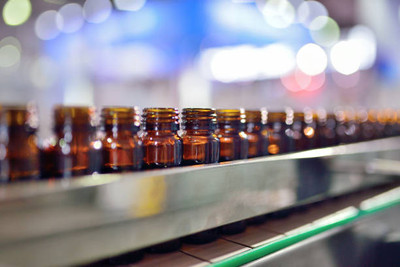How are coloured bottles and glasses made?
Posted by The Wares Team on 26th May 2021
At Wares of Knutsford, we stock a fantastic coloured glass bottle and coloured glass jar range. Our customers buy these beautiful products for all kinds of special occasions, for their businesses, or to decorate their homes and kitchens. Glass is a fantastic storage material for all types of foods, drinks and beauty products and it's infinitely recyclable too - something that is very important to many of our customers who are looking to reduce their carbon footprint.
We're all used to coloured glass in different guises. Green wine bottles, brown beer bottles, blue gin bottles! Also the coloured glass used in traffic lights and the coloured glass that appears in decorative items such as lamps or stained glass windows.
But how exactly is coloured glass made?
There are actually several different methods of making coloured glass. The chosen method will depend on factors such as the end purpose of the glass, the cost and the materials that will be used. Glass artists will use different aesthetically-led methods from commercial manufacturers who are likely to be more driven by factors such as cost management and quality standards.
How glass is composed
Before considering the use of colour in more detail, it's worth understanding more about the chemical composition of the coloured glass bottle you might be holding in your hand. Different types of glass have different applications. Most of the glass we use daily - such as a coloured glass jar that holds food or a bubble bath - is a soda-lime variety made mainly from silicon dioxide, sodium oxide (soda) and calcium oxide (lime.) This type of glass is used for containers, bottles, drinking glasses and window panes.
Another, more specialist type of glass might be found in a coloured glass bottle used for scientific applications in a laboratory. In these instances, the type of glass used is borosilicate. It also contains boron trioxide, alongside silicon dioxide to give it a higher degree of durability, plus extra heat resistance and chemical resistance. This makes it ideal for scientific use as well as for cookware, and also flashlight lenses - as this type allows more light to permeate than plastic alternatives.
Other types of glass include lead glass, although this isn't found very commonly in most everyday types of glass.
How coloured glass is made
There are three main ways of making coloured glass. The first one involves adding a rare earth metal oxide or a transition metal to the glass itself. Usually, this is done via metal oxides, and these absorb light wavelengths, which vary according to the type of metal used. The finished result is one of colour.
A second approach involves forming colloidal particles. This basically means adding substance particles throughout the entire material of the glass, usually with a heat treatment. These can be used to create so-called 'striking colours' in the glass, as they scatter light particles as frequencies travel through the glass, and create colour. One example is a gold colloidal, which creates a ruby red colour. Selenium is also used to create shades that vary from a pale pink to an intense ruby red.
There's a third way of creating that coloured glass jar too - by adding particles that have already been coloured to the glass. This is how smoked and milk glass are achieved- by adding in coloured elements such as tin oxide.
The different purposes of coloured glass
Coloured glass can be used for both decorative and functional purposes. Stained glass uses metal ions to create different shades. But a coloured glass bottle won't be coloured simply for aesthetics. For example, a brown or green beer bottle is coloured that way to cut out certain UV light waves which can spoil the flavour and lifespan of the drink. Similarly, essential oils and some beauty products will be stored in dark coloured glasses to avoid spoilage.
Making use of coloured glass
Glass making is a skilled process that involves expertise, time, careful mixing of materials and extremely high heat. But glass is well worth the effort, as it is infinitely recyclable, safe to use and extremely flexible. It is a great material for storing everything from food and drink through to beauty preparations, and also for decorating the home. Think how lovely a coloured glass bottle or a coloured glass jar looks on a bright windowsill, for example.
Why not explore the full range of coloured glass at Wares of Knutsford. We are constantly developing our product range to include the latest and best products for our customers and we sell in bulk or on palletts for some of our popular products which tend to be useful for businesses.
We offer excellent customer service, affordable delivery and top-quality products all at highly competitive prices, so why not have a look at our coloured glass range today and see what inspires you!

